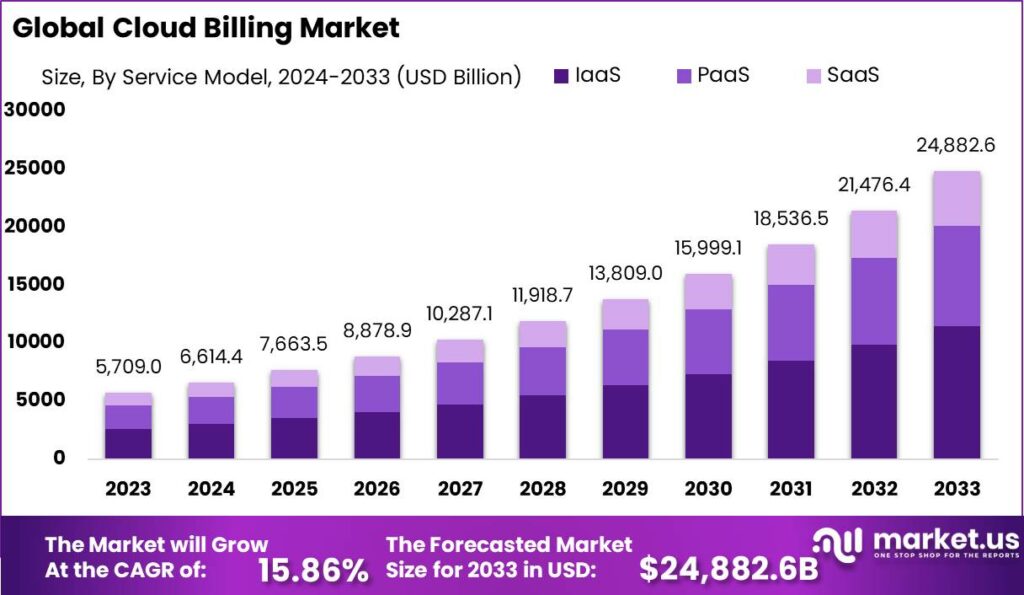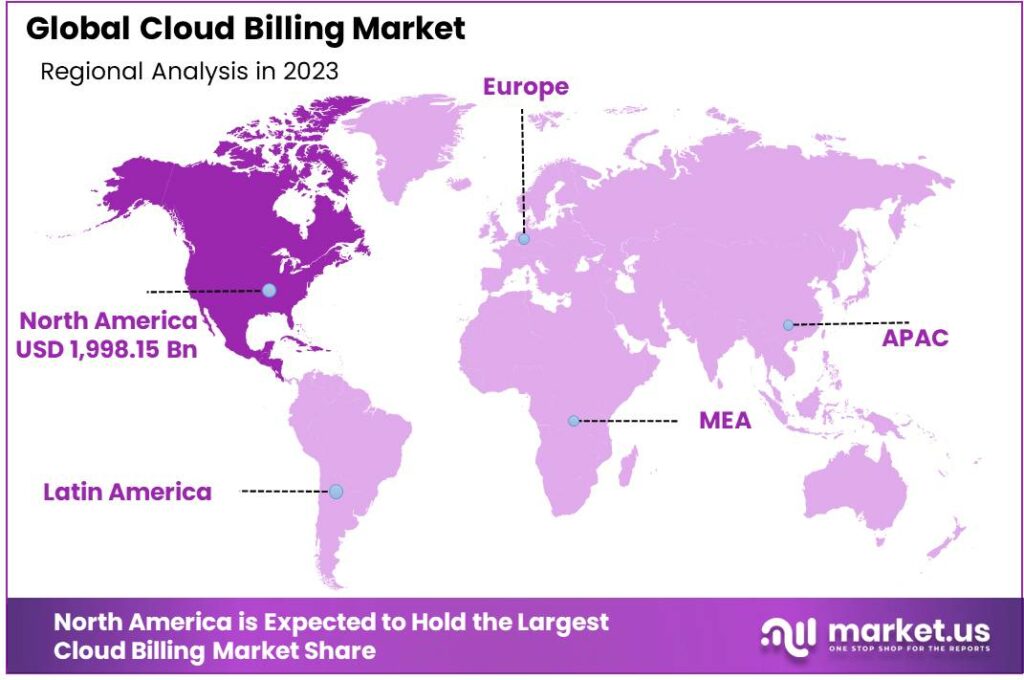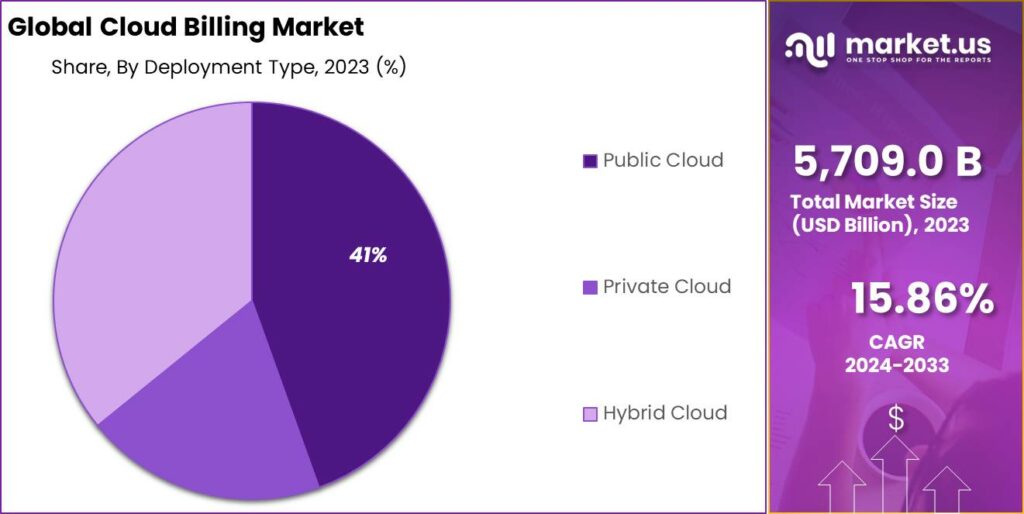New York, Feb. 12, 2024 (GLOBE NEWSWIRE) -- The Cloud Billing Market size was projected to be USD 5,709.0 billion in 2023, and by the end of 2024, it is expected to reach a valuation of USD 6,614.4 billion. During the forecast period (2024-2033), the global cloud billing Market is forecasted to exhibit a 15.86% Compound Annual Growth Rate (CAGR), reaching a substantial size of USD 24,882.6 billion by 2033.
Cloud billing involves monitoring and measuring resource utilization, applying pricing models, calculating costs, and generating invoices or billing statements. It provides organizations with transparency and control over their cloud expenses, allowing them to optimize resource allocation, manage budgets, and ensure accurate cost allocation across departments or projects.
The cloud billing market has experienced significant growth in recent years, driven by the rapid adoption of cloud services across industries. Organizations of all sizes, from small startups to large enterprises, are leveraging cloud computing to enhance their operations and scale their infrastructure. As a result, the demand for robust cloud billing solutions has surged.
Buy Now this Premium Report to Grow your Business: https://market.us/purchase-report/?report_id=114737
The cloud billing market encompasses a wide range of vendors and solutions, including specialized billing platforms, cloud service providers offering built-in billing capabilities, and third-party billing management systems. These solutions often integrate with cloud service providers' APIs to collect usage data and automate the billing process.

Key features of cloud billing systems include flexible pricing models, real-time monitoring and reporting, scalability to handle large volumes of data, support for multiple currencies and payment gateways, and integration with other business systems such as customer relationship management (CRM) and enterprise resource planning (ERP) software.
The cloud billing market is competitive, with vendors constantly innovating to provide more advanced features and cater to evolving customer needs. As organizations continue to migrate their workloads to the cloud and adopt multi-cloud or hybrid cloud strategies, the demand for comprehensive and efficient cloud billing solutions is expected to grow further.
Important Revelation:
- Market Growth Projection: The cloud billing market is expected to witness substantial growth, with a projected worth of USD 24,882.6 billion by 2033, marking a significant increase from USD 5,709 billion in 2023.
- Segment Dominance in 2023:
- Platform Segment: Held a dominant market position, capturing over 72.3% share in 2023.
- Usage-based Billing Type: Also held a significant market share, accounting for more than 36% in 2023.
- SaaS (Software as a Service) Service Model: Dominated the market with over 46% share in 2023.
- Public Cloud Deployment Type: Captured a substantial share, accounting for over 41% in 2023.
- Large Organizations: Led the market, holding over 63% share in 2023.
- BFSI (Banking, Financial Services, and Insurance) Industry Vertical: Held a dominant position with over 27% share in 2023.
- Regional Analysis: North America: Held a dominant market position in 2023, with a share of over 35%, driven by early adoption of cloud technologies and a robust digital infrastructure.
- Leading Market Players: Amazon Web Services (AWS), Microsoft Corporation, Zuora, ConnectWise, Aria Systems, SAP SE, Salesforce, Cerillion, BillingPlatform, Recurly, Chargify, and Comarch are among the top market players contributing to market growth.
Download Exclusive Sample of this Premium Report@ https://market.us/report/cloud-billing-market/request-sample/
Key Influencers in the Cloud Billing Market Growth
The cloud billing market is influenced by several key factors that contribute to its growth and development. Here are some of the key influencers in the cloud billing market growth:
- Increasing Adoption of Cloud Services: The growing adoption of cloud services across various industries is a significant influencer in the cloud billing market growth. As more businesses migrate their operations to the cloud, the demand for efficient and scalable billing solutions that can handle cloud-based subscriptions, usage-based pricing, and pay-as-you-go models increases. Cloud billing systems enable businesses to accurately track and bill for cloud services, making them an essential component in the cloud ecosystem.
- Cost Optimization and Efficiency: Cost optimization and operational efficiency are crucial factors driving the adoption of cloud billing solutions. Cloud billing systems streamline the billing process, automate invoicing, and provide real-time visibility into resource usage and costs. By efficiently managing billing and invoicing processes, businesses can optimize their cloud spending, reduce manual errors, and improve financial management.
- Flexible Pricing Models: Cloud billing solutions offer flexibility in pricing models, allowing businesses to adopt various billing strategies to meet customer demands. This includes subscription-based models, usage-based models, tiered pricing, and metered billing. The ability to easily configure and adapt pricing models to cater to different customer segments and business requirements is a key influencer in the adoption of cloud billing solutions.
- Scalability and Elasticity: Scalability and elasticity are fundamental characteristics of cloud computing, and they also influence the cloud billing market. Cloud billing solutions are designed to scale seamlessly as businesses grow and accommodate fluctuations in demand. These systems can handle large volumes of billing data and support the dynamic nature of cloud services, ensuring accurate and timely billing for resources consumed.
Regional Analysis:
In 2023, North America asserted its dominance in the cloud billing sector, securing a commanding market position with a share exceeding 35%. The region's robust demand for cloud billing services was underscored by its staggering valuation, reaching US$ 1,998.15 billion in the same year.
This substantial market share and valuation highlight North America's leadership in embracing cloud-based billing solutions, driven by factors such as technological innovation, widespread adoption of cloud computing, and a dynamic business landscape conducive to digital transformation. With its mature market ecosystem, sophisticated infrastructure, and proactive regulatory environment, North America continues to set the pace for cloud billing advancements, positioning itself as a key influencer in shaping the global landscape of cloud-based billing services.

Top Market Leaders
- Zuora
- Amazon Web Services, Inc.,
- ConnectWise, LLC.
- Aria Systems, Inc.
- SAP SE
- Salesforce
- Cerillion
- BillingPlatform
- Recurly, Inc.
- Chargify LLC.
- Comarch
- Other key players
Scope of the Report
| Report Attributes | Details |
| Market Value (2023) | US$ 5,709.0 Bn |
| Forecast Revenue 2033 | US$ 24, 882.6 Bn |
| CAGR (2024 to 2033) | 15.86% |
| North America Revenue Share | 35% |
| Base Year | 2023 |
| Historic Period | 2018 to 2022 |
| Forecast Year | 2024 to 2033 |
Purchase the Competition Analysis Dashboard Today: https://market.us/purchase-report/?report_id=114737
Report Segmentation
Component Analysis:
In 2023, the Platform segment held a dominant market position in the cloud billing market, capturing more than a 72.3% share. The platform component refers to the infrastructure and software frameworks that enable the delivery and management of cloud billing services. Cloud billing platforms provide the necessary tools and functionalities to handle billing processes, such as invoice generation, subscription management, pricing configuration, and reporting.
The dominance of the platform segment indicates the significance of comprehensive and feature-rich cloud billing platforms that cater to the diverse needs of businesses across different industries. These platforms offer scalability, flexibility, and customization options, allowing organizations to streamline their billing operations and adapt to evolving business requirements.
Billing Type Analysis:
In 2023, the Usage-based segment held a dominant market position in the cloud billing market, capturing more than a 36% share. Usage-based billing refers to a pricing model where customers are charged based on their actual usage of cloud resources or services. This billing type is particularly relevant in cloud environments where resources are consumed on a pay-per-use basis. Usage-based billing provides transparency and cost control for customers, as they are billed only for the resources they utilize. It also offers flexibility for businesses, allowing them to align costs with actual usage and scale their resources up or down as needed. The dominance of the usage-based segment reflects the growing popularity of this billing model and the increasing demand for accurate and granular billing based on resource consumption.
Service Model Analysis:
In 2023, the SaaS (Software as a Service) segment held a dominant market position in the cloud billing market, capturing more than a 46% share. SaaS-based cloud billing solutions are provided as a service, allowing businesses to access billing functionalities through a web-based application without the need for on-premises infrastructure or software installation.
SaaS cloud billing solutions offer advantages such as ease of deployment, reduced IT overhead, automatic updates, and scalability. The dominance of the SaaS segment indicates the preference of businesses for cloud billing solutions that offer a hassle-free and cost-effective way to manage their billing processes. SaaS-based solutions provide flexibility and accessibility, enabling organizations of all sizes to leverage advanced billing capabilities without significant upfront investments.
Organization Size Analysis:
In 2023, the Large Organizations segment held a dominant market position in the cloud billing market, capturing more than a 63% share. Large organizations refer to enterprises with a significant scale of operations and a substantial customer base. The dominance of the large organizations segment can be attributed to factors such as complex billing requirements, the need for scalable solutions, and the ability to invest in advanced cloud billing systems.
Large organizations typically handle a high volume of transactions and require robust billing capabilities to manage their billing processes efficiently. They also have the resources and infrastructure to implement and maintain comprehensive cloud billing solutions, making them the leading adopters of such systems.
Industry Vertical Analysis:
In 2023, the BFSI (Banking, Financial Services, and Insurance) segment held a dominant market position in the cloud billing market, capturing more than a 27% share. The dominance of the BFSI segment can be attributed to the specific billing requirements and regulatory compliance challenges faced by the banking, financial services, and insurance industry. These sectors often deal with complex billing structures, recurring payments, and stringent data security and privacy regulations.
Cloud billing solutions tailored to address the unique needs of the BFSI industry, such as multi-tiered pricing, automated invoicing, and secure payment processing, are in high demand. The BFSI segment's dominance reflects the industry's recognition of the value and benefits that cloud billing solutions bring to their billing operations.
Deployment Type Analysis:
In 2023, the Public Cloud segment held a dominant market position in the cloud billing market, capturing more than a 41% share. Public cloud deployment refers to the utilization of cloud infrastructure and services provided by third-party cloud service providers. Public cloud environments offer scalability, cost efficiency, and accessibility, making them a popular choice for organizations seeking cloud billing solutions.
The dominance of the public cloud segment indicates the preference for cloud billing systems that can leverage the advantages of public cloud infrastructure, such as on-demand resource provisioning and high availability. Public cloud deployment also facilitates easy integration with other cloud-based applications and services, enabling seamless billing operations in a cloud environment.
To Gain greater insights, Request a sample report @ https://market.us/report/cloud-billing-market/request-sample/

Key Market Segments
By Component
- Platform
- Services
By Billing Type
- Subscription
- Usage Based
- One-Time
- Others
By Service Model
- IaaS
- PaaS
- SaaS
By Deployment Type
- Private Cloud
- Public Cloud
- Hybrid Cloud
By Organization Size
- Large Enterprises
- Small & Medium
By Industry Vertical
- BFSI
- IT & Telecommunication
- Retail
- Healthcare
- Media and Entertainment
- Others
By Geography
- North America
- US
- Canada
- Europe
- Germany
- France
- The UK
- Spain
- Italy
- Russia
- Netherland
- Rest of Europe
- Asia Pacific
- China
- Japan
- South Korea
- India
- New Zealand
- Singapore
- Thailand
- Vietnam
- Rest of APAC
- Latin America
- Brazil
- Mexico
- Rest of Latin America
- Middle East & Africa
- South Africa
- Saudi Arabia
- UAE
- Rest of MEA
Explore Extensive Ongoing Coverage on Technology and Media Reports Domain:
- Aircraft seat actuation systems market is anticipated to be USD 2,208.3 billion by 2033. It is estimated to record a steady CAGR of 11.9%
- Generative AI in Autonomous Vehicles Market is likely to attain a valuation of USD 20.3 Billion by 2033, rise at an astounding CAGR of 21.1%.
- Airborne Optronics Market is anticipated to be USD 6.2 billion by 2033. It is estimated to record a steady CAGR of 12.5% in the Forecast period 2024 to 2033. It is likely to total USD 1.9 billion in 2023.
- Contactless Payments Market is expected to grow USD 90.6 bn in 2032. This market is estimated to register a CAGR of 15.4%.
- Antivirus Software Market is projected to reach a revised size of USD 6.2 Million by 2033, growing at a CAGR of 4.0% during Forecast Period.
- Data Converter Market size is expected to be worth around USD 9 Bn by 2032, growing at a CAGR of 6.00% during the forecast period.
- Hyper Automation Market size is expected to be worth around USD 155 Billion by 2032 from USD 36 Billion in 2022, growing at a CAGR of 16.30%.
- Smart Antenna market is anticipated to be USD 17.4 billion by 2032. It is estimated to record a steady CAGR of 9.2% in the Forecast period.
- Crop Monitoring Market was at USD 2.6 Bn in 2022. It is estimated to reach USD 9.8 Bn in 2032 at a CAGR of 14.6% between 2023 and 2032.
- Photogrammetry Software Market size is expected to be worth around USD 3,14.69 Million by 2032, growing at a CAGR of 12.80%.
- Wearable sensors market is anticipated to be USD 10.19 billion by 2033. It is estimated to record a steady CAGR of 12.8% in forecast period.
- Adaptive Optics market is projected to approximately USD 4,828.7 Bn by 2032; grow at a CAGR of 25.1% during forecast period.
- Digital Multimeter Market is projected to reach a valuation of USD 1,514.3 Mn by 2033, at a CAGR of 5.8%, from USD 861.7 Mn in 2023.
About Us
Market.US (Powered by Prudour Pvt Ltd) specializes in in-depth market research and analysis and has been proving its mettle as a consulting and customized market research company, apart from being a much sought-after syndicated market research report-providing firm. Market.US provides customization to suit any specific or unique requirement and tailor-makes reports as per request. We go beyond boundaries to take analytics, analysis, study, and outlook to newer heights and broader horizons.
Follow Us On LinkedIn Facebook Twitter
Our Blog:
